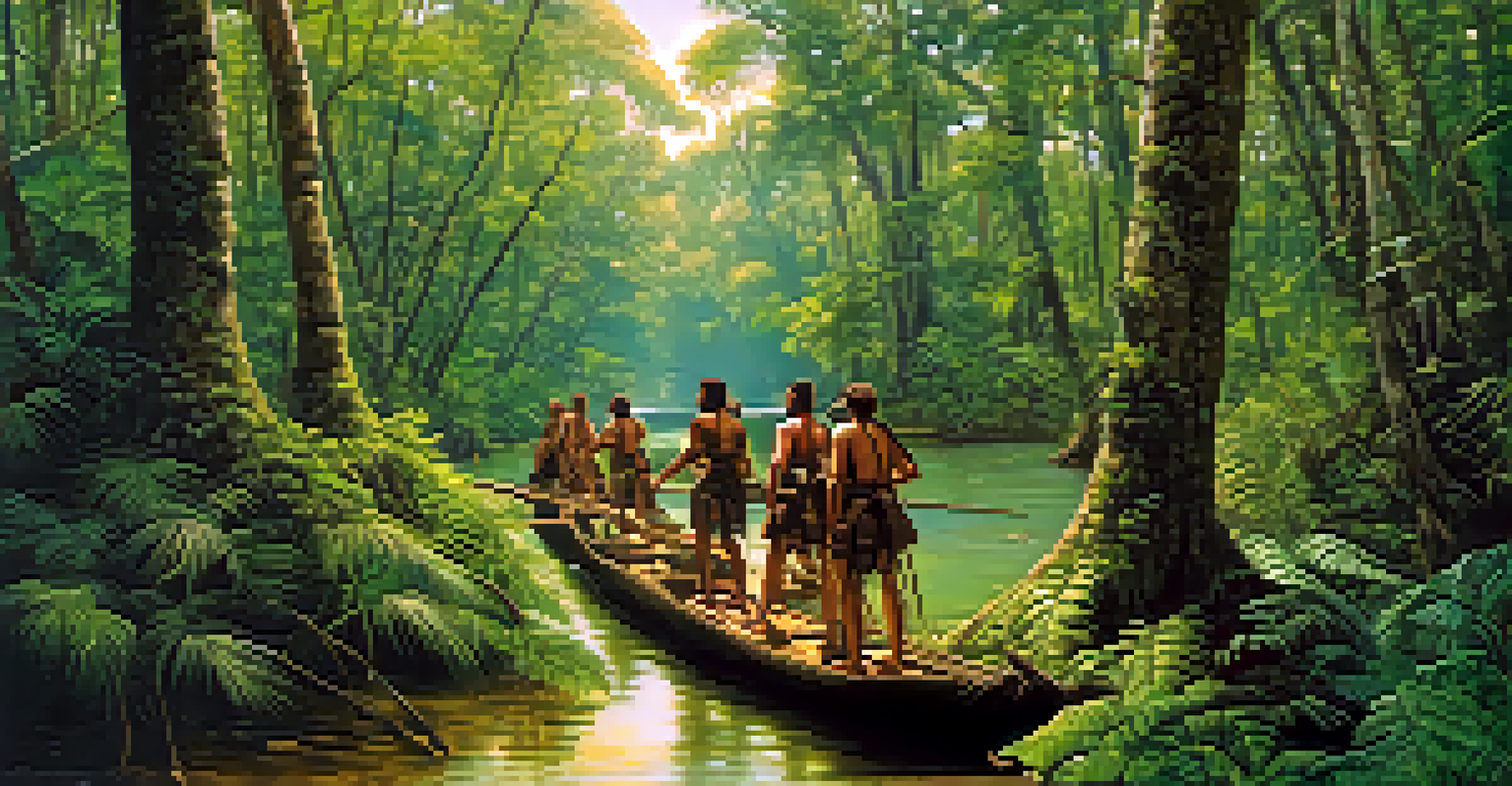Spanish Explorations: The First European Contacts in Florida

Introduction to Spanish Exploration in Florida
The Spanish exploration of Florida began in the early 16th century, driven by the quest for wealth and territory. Pioneering explorers sought new lands for Spain, motivated by stories of gold and glory. Florida, with its lush landscapes and coastal allure, became a prime target for these ambitious adventurers.
Exploration knows no bounds, and the pursuit of knowledge propels us to new frontiers.
As Spain established its presence in the New World, Florida emerged as a significant location for exploration. Figures like Juan Ponce de León led the charge, famously searching for the Fountain of Youth. This quest symbolized the era's fascination with mythical riches and the desire for discovery.
These early explorations laid the groundwork for the complex interactions between European explorers and Indigenous peoples. The encounters would shape the future of Florida, marking the beginning of a transformative period in the region's history.
Juan Ponce de León: The First European to Explore Florida
In 1513, Juan Ponce de León made his historic landfall on the east coast of Florida, becoming the first documented European to explore the area. His arrival marked a pivotal moment, as he claimed the land for Spain, naming it 'La Florida' in honor of the blooming flowers he encountered. This event paved the way for future Spanish expeditions and settlements.

Ponce de León's journey was fueled by legends of a magical fountain promising eternal youth. Although he never found this mythical spring, his expedition sparked interest and curiosity about the region. The tales of his adventures spread, inspiring subsequent explorers to venture into Florida’s uncharted territories.
Spanish Exploration Fueled by Wealth
The Spanish exploration of Florida in the 16th century was driven by the desire for gold and new territories.
Despite the challenges he faced, including hostile encounters with Indigenous tribes, Ponce de León's explorations opened the door for future European contacts. His legacy is a reminder of the adventurous spirit of the age and the intricate stories of exploration that shaped Florida.
The Impact of Spanish Missions in Florida
Following initial explorations, the Spanish established missions throughout Florida to convert Indigenous peoples to Christianity. These missions served both religious and cultural purposes, acting as centers of education and agriculture. The introduction of European customs transformed local communities, impacting their way of life.
To be truly adventurous is to embrace the unknown, for therein lies the essence of discovery.
Missions like San Luis de Talimali became focal points for Spanish influence in the region. They provided shelter and resources, but also led to significant cultural exchanges—both positive and negative. While some Indigenous groups adopted new practices, others resisted the intrusion of foreign beliefs and lifestyles.
The establishment of these missions marked a crucial chapter in Florida's history, as they fostered a blending of cultures. This period showcased the complex dynamics of colonialism, where faith, power, and resistance intertwined in the lives of the people.
Hernando de Soto: A Journey Through Florida
In 1539, Hernando de Soto embarked on an ambitious expedition through Florida, seeking gold and new territories. His explorations took him deep into the southeastern United States, where he encountered various Indigenous tribes. De Soto's journey was marked by both discovery and conflict, reflecting the tumultuous nature of European colonization.
De Soto's expedition faced numerous challenges, including hostile encounters with Native Americans and the harsh realities of the landscape. Despite these obstacles, he contributed to the mapping of Florida and its surrounding regions. His travels laid the groundwork for future explorers and settlers who would follow in his footsteps.
Cultural Exchange Through Missions
Spanish missions in Florida facilitated both the spread of Christianity and significant cultural interactions with Indigenous peoples.
While De Soto's expedition ultimately ended in tragedy, it left a lasting impact on the history of Florida. His interactions with Indigenous peoples underscored the complexities of cultural exchange, as well as the consequences of European expansion into new lands.
The Role of Indigenous Peoples in Spanish Exploration
The Indigenous peoples of Florida played a crucial role in the Spanish explorations, influencing outcomes in both significant and subtle ways. Their knowledge of the land and resources proved invaluable to explorers like Ponce de León and De Soto. However, these interactions also led to misunderstandings and conflicts that would reshape their societies.
Many Indigenous groups initially welcomed the Spanish, intrigued by their technologies and goods. However, as explorations progressed, the impact of European diseases and territorial encroachments devastated local populations. The rapid changes brought by Spanish contact led to a loss of autonomy for many tribes.
Despite the challenges, Indigenous peoples displayed resilience and adaptability. Their stories and experiences remind us of the complexities of this historical narrative, showcasing how encounters with European explorers were not one-sided, but rather a tapestry of diverse perspectives and experiences.
Spanish Colonization Efforts and Their Challenges
The Spanish efforts to colonize Florida faced numerous challenges, from natural obstacles to resistance from Indigenous tribes. Settlements like St. Augustine, established in 1565, became focal points of Spanish colonial life. However, sustaining these colonies proved difficult due to conflicts and dwindling resources.
The harsh environments, including hurricanes and swamps, tested the settlers' resilience. Additionally, ongoing skirmishes with Indigenous groups complicated the establishment of stable communities. Spain's attempts to solidify its presence in Florida were often met with fierce resistance and adaptability from Native peoples.
Indigenous Impact on Exploration
Indigenous peoples played a crucial role in shaping the outcomes of Spanish explorations, providing knowledge while facing devastating consequences.
Despite these struggles, the Spanish influence in Florida persisted, leading to a unique blend of cultures. The legacies of these early settlements can still be felt today, as they contributed to the rich tapestry of Florida's history and identity.
Conclusion: The Legacy of Spanish Explorations in Florida
The Spanish explorations of Florida left an indelible mark on the region's history and identity. From the quest for gold to the establishment of missions, these early encounters shaped the cultural landscape of Florida. The stories of explorers like Ponce de León and De Soto continue to resonate today.
These explorations were not only about discovery but also about the complex relationships formed between Europeans and Indigenous peoples. The impact of colonization can still be observed in Florida's diverse cultural heritage, blending Indigenous traditions with Spanish influences.

As we reflect on this history, it's essential to recognize the multifaceted narratives that define Florida's past. The Spanish explorations serve as a reminder of the adventurous spirit of exploration, the challenges of cultural exchange, and the enduring legacies of those who walked these lands long before us.